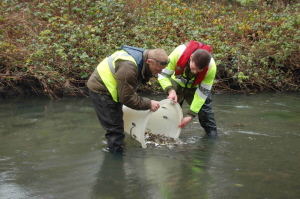River Crane re-stocked with more than 5,000 fish
Four Year Project underway to replenish river
Several thousand fish have been released throughout the River Crane as part of a river restoration project.
The Environment Agency, working as part of the Crane Valley Partnership which aims to restore the River Crane, released 1,500 chub, 1,500 dace, 1,500 roach and 1,000 barbel into the river.

They were introduced downstream of Staines Road, North Feltham and were taken from the Environment Agency’s own Calverton Fish Farm.
The recent fish re-stocking was carried out after an estimated minimum of 10,000 fish were wiped out during a major pollution incident on the River Crane and the Duke of Northumberland's River near North Feltham in October 2011. Among the species of fish killed were mature chub, barbel, pike and eel.
Crane Valley Partnership Chair, Jean Rolfe said: “It is a great step in the river’s recovery to see fish returned through the Environment Agency’s recent re-stocking. This indicates that both the water quality and food sources have recovered enough to sustain new fish.
“The river is such an important part of the local community and an incredibly valuable wildlife corridor, that it was staggering to see the degree of damage caused by the pollution. It was therefore a great end to 2012 to see the river accept new life on its road to recovery."
The fish put back into the river were between one and two-years-old, ranging in size from 8cm-15cm.
Fisheries Technical Officer at the Environment Agency, Neil Winter, was assisted by Rupert Newby, Access and Recreation Manager at Thames Water Utilities Limited.
Mr Winter said: “The pollution of the River Crane in 2011 had a devastating impact on the fish, killing thousands. Since then we have worked closely with the Crane Valley Partnership to re-charge the river with fish and restore it to its former glory.
“This initial stocking of 5,500 fish will be the start of a four-year fish stocking program to help initiate a recovery of the fish population.
“We will continue to assess the long term impact of the ecology of the river. Through strong partnerships and a strategic approach we hope to ensure that this incredible local asset recovers and improves over time.”
January 17, 2013